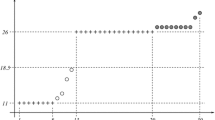Abstract
If a biconnected graph stays connected after the removal of an arbitrary vertex and an arbitrary edge, then it is called 2.5-connected. We prove that every biconnected graph has a canonical decomposition into 2.5-connected components. These components are arranged in a tree-structure. We also discuss the connection between 2.5-connected components and triconnected components and use this to present a linear time algorithm which computes the 2.5-connected components of a graph. We show that every critical 2.5-connected graph other than \(K_4\) can be obtained from critical 2.5-connected graphs of smaller order using simple graph operations. Furthermore, we demonstrate applications of 2.5-connected components in the context of cycle decompositions and cycle packings.
This research was partially funded by the European Research Council (ERC) under the European Union’s Horizon 2020 research and innovation programme (EngageS: grant agreement No. 820148), and the Federal Ministry of Education and Research.
Access this chapter
Tax calculation will be finalised at checkout
Purchases are for personal use only
Similar content being viewed by others
Notes
- 1.
This differs from the definition of 2-connected graphs as can be found in [3]. Connected graphs of order 2 are biconnected but not 2-connected.
- 2.
Recall the definition of \(S(\mathcal {I})\) from Lemma 1.
- 3.
Recall the definition of \(S(\mathcal {I})\) from Lemma 1.
- 4.
Originally, Hajós conjectured that at most \(\nicefrac {1}{2}|V(G)|\) cycles are needed. This equivalent reformulation is due to Fan and Xu, cf. [4].
References
di Battista, G., Tamassia, R.: On-line planarity testing. SIAM J. Comput. 25(5), 956–997 (1996). https://doi.org/10.1137/s0097539794280736
Beineke, L.W., Wilson, R.J., Oellermann, O.R.: Topics in Structural Graph Theory. Cambridge Univ. Press, Cambridge (2012)
Diestel, R.: Graph Theory. Graduate Texts in Mathematics. Springer, Heidelberg (2000)
Fan, G., Xu, B.: Hajós’ conjecture and projective graphs. Discrete Math. 252(1), 91–101 (2002). https://doi.org/10.1016/s0012-365x(01)00290-4
Fuchs, E., Gellert, L., Heinrich, I.: Cycle decompositions of pathwidth-\(6\) graphs. J. Graph Theory (2019). https://doi.org/10.1002/jgt.22516
Girão, A., Granet, B., Kühn, D., Osthus, D.: Path and cycle decompositions of dense graphs. arXiv preprint arXiv: 1911.05501 (2019)
Grohe, M.: Quasi-4-connected components. In: 43rd International Colloquium on Automata, Languages, and Programming (ICALP 2016) (2016). https://doi.org/10.4230/LIPIcs.ICALP.2016.8
Gutwenger, C., Mutzel, P.: A linear time implementation of SPQR-trees. In: Marks, J. (ed.) GD 2000. LNCS, vol. 1984, pp. 77–90. Springer, Heidelberg (2001). https://doi.org/10.1007/3-540-44541-2_8
Heinrich, I., Heller, T., Schmidt, E., Streicher, M.: 2.5-connectivity: unique components, critical graphs, and applications. arXiv preprint arXiv: 2003.01498 (2020)
Heinrich, I., Streicher, M.: Cycle decompositions and constructive characterizations. Electron. J. Graph Theory Appl. 7(2), 411–428 (2019). https://doi.org/10.5614/ejgta.2019.7.2.15
Hopcroft, J.E., Tarjan, R.E.: Dividing a graph into triconnected components. SIAM J. Comput. 2, 135–158 (1973). https://doi.org/10.1137/0202012
Mac Lane, S.: A structural characterization of planar combinatorial graphs. Duke Math. J. 3(3), 460–472 (1937). https://doi.org/10.1215/S0012-7094-37-00336-3
Nagamochi, H., Ibaraki, T.: Algorithmic Aspects of Graph Theroy. Cambridge University Press, Cambridge (2008)
Tutte, W.T.: A contribution to the theory of chromatic polynomials. Can. J. Math. 6, 80–81 (1954). https://doi.org/10.4153/cjm-1954-010-9
Tutte, W.T.: Connectivity in Graphs. University of Toronto Press (1966). https://doi.org/10.3138/9781487584863
Wormald, N.C.: Classifying K-connected cubic graphs. In: Horadam, A.F., Wallis, W.D. (eds.) Combinatorial Mathematics VI. LNM, vol. 748, pp. 199–206. Springer, Heidelberg (1979). https://doi.org/10.1007/BFb0102696
Author information
Authors and Affiliations
Corresponding author
Editor information
Editors and Affiliations
Rights and permissions
Copyright information
© 2020 Springer Nature Switzerland AG
About this paper
Cite this paper
Heinrich, I., Heller, T., Schmidt, E., Streicher, M. (2020). 2.5-Connectivity: Unique Components, Critical Graphs, and Applications. In: Adler, I., Müller, H. (eds) Graph-Theoretic Concepts in Computer Science. WG 2020. Lecture Notes in Computer Science(), vol 12301. Springer, Cham. https://doi.org/10.1007/978-3-030-60440-0_28
Download citation
DOI: https://doi.org/10.1007/978-3-030-60440-0_28
Published:
Publisher Name: Springer, Cham
Print ISBN: 978-3-030-60439-4
Online ISBN: 978-3-030-60440-0
eBook Packages: Computer ScienceComputer Science (R0)




